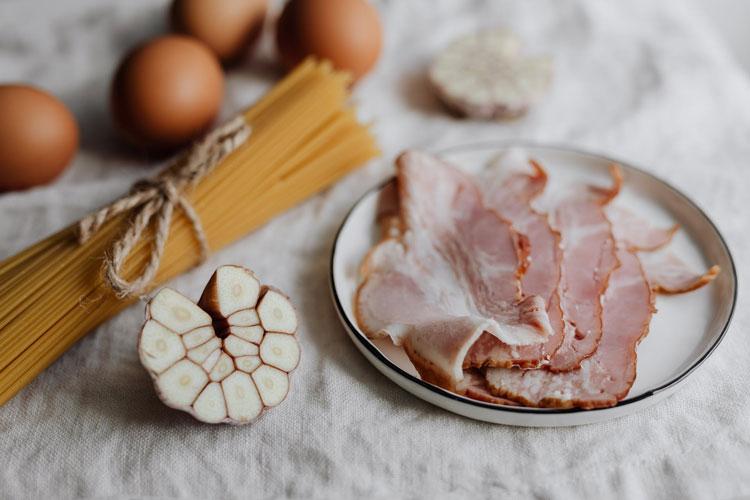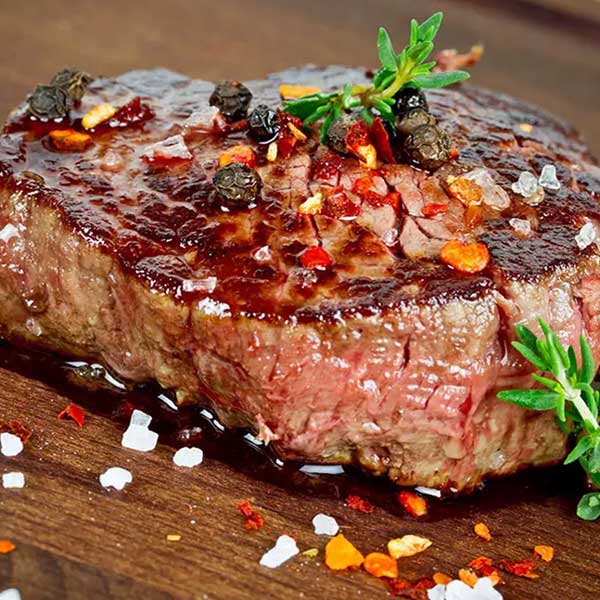Bacon is a cured and smoked pork product that comes from the belly or back cuts of a pig. It has a rich, savoury flavour and crispy texture when cooked.
Bacon has been around for centuries, with origins dating back to 1500 BC in China. The ancient Romans also enjoyed bacon, which they called petaso. Modern mass production of bacon began in the 1800s and it became a breakfast staple in North America during the early 1900s.
There are many ways to prepare, cure, smoke, slice, and flavour bacon. The main cuts used are pork belly and pork loin. Bacon can be sold in thin to thick slices and differ in smokiness, seasoning, and whether it is smoked or unsmoked. Popular styles around the world include American bacon, Canadian bacon, British bacon, and pancetta.
This guide will provide an in-depth look at the different cuts, thicknesses, flavours, and varieties of bacon available. It will cover topics like smoked vs uncured bacon, international styles, cooking methods, popular uses, and health considerations. With this information, you’ll gain a well-rounded understanding of sliced bacon’s characteristics and uses.
Pork Belly vs Pork Loin Bacon
Bacon comes from two main cuts of pork – the pork belly and the pork loin. The key differences between belly bacon and loin bacon come down to fat content, flavour, and texture.
Pork belly bacon is cut from the fatty belly section of the pig. It has streaks of fat running through it and a higher overall fat content, around 50% fat. Belly bacon has a more robust, meaty pork flavour and a tender, chewy texture when cooked. The fat renders to become crispy. Belly bacon is ideal for dishes where you want that classic rich bacon taste and texture. It works well in bacon sandwiches, baked into casseroles and potatoes, or chopped up for sauces and soups.
Pork loin bacon comes from the leaner loin section. It has less fat marbled throughout, closer to 10% fat. Loin bacon has a milder pork flavour and a firmer, drier texture when cooked. With less fat, it can end up tougher and chewier if overcooked. Loin bacon is better suited to dishes where you want little smokiness and a tender bite. It works well diced up in salads, omelettes, or pasta dishes. The leanness also makes it a healthier choice for those looking to limit fat intake.
The right bacon to choose comes down to the flavour, fat content, and texture you want in your dish. Belly bacon brings rich pork flavour and crispy fat. Loin bacon brings a milder taste and leaner bite. Understanding the differences allows you to pick the optimal bacon for your cooking needs.
Bacon Cuts

Bacon can be cut into a variety of shapes and sizes, each suited for different cooking methods and recipes. The main cuts are:
Slab Bacon
This refers to a side of pork belly that has been cured and smoked in one large, continuous piece. Slab bacon is often what you find packaged for sale in grocery stores. The slab can be sliced to any thickness. Slab bacon holds up well to high heat cooking methods like pan frying or baking in the oven.
Sliced Bacon
This is what most people think of as regular bacon. It consists of thin, long slices cut from a side of cured slab bacon. The average commercial slice is around 0.10 inches thick. Sliced bacon is great for recipes like bacon eggs, sandwiches, BLTs, etc. It provides those iconic crispy strips of bacon.
Lardons
Lardons are small matchsticks or cubes of bacon, usually around 1/4 inch thick. They are produced by cutting the bacon slices into strips or cubes. Lardons are ideal for stews, soups, salads, pasta and other dishes where you want the bacon flavour infused throughout. The small shape allows them to crisp up nicely.
Diced Bacon
As the name suggests, this is bacon that has been diced into small cubes, around 1/4 inch in size. The dice shape works well for similar dishes as lardons. It provides lots of crispy bacon pieces in each bite. Omelettes, frittatas, home fries and creamed dishes all benefit from diced bacon.
So, in summary, the bacon cut should match the cooking method and desired texture in the final dish. Slab bacon offers complete control over thickness and portioning. Sliced bacon provides those iconic crispy strips. Lardons and diced bacon infuse dishes with crispy, bacony flavour.
Bacon Thickness
When shopping for bacon, you’ll notice it comes in different thicknesses. The three main sizes are thin, regular, and thick cut.
Thinner bacon is around 1/16 inch thick. It has a delicate texture and cooks faster than thicker cuts, so it’s ideal for dishes where you want the bacon crisp or extra crispy. Thin bacon is great for sandwiches, BLTs, salads, and bacon bits.
Regular cut bacon is approximately 1/8 inch thick. This is the most common thickness you’ll find. Regular bacon provides a good balance of meaty flavour and crispy texture when fried. It’s versatile for all kinds of recipes from breakfast plates to burgers and more.
Thick cut bacon is around 1⁄4 inch or more. It has a very meaty, fatty texture and usually stays chewy even when cooked. Thick cut bacon is great for dishes where you want the bacon to remain pliable and not become rigid after cooking, like bacon wraps. The thickness also allows the bacon to retain a soft texture inside while crisping up on the outer edges.
The thickness you choose really depends on the texture you want and how you plan to use the bacon. Thinner cuts are best for baked dishes or times when you want it extra crispy. Go for a thicker cut when you want to maintain pliability. Testing out different thicknesses can help you find your personal preference.
Smoked vs Uncured Bacon
Bacon can be categorized into two main types: smoked and uncured. The key difference lies in how the pork belly is processed and preserved.
Smoked bacon is cured with salt, smoked with natural wood smoke, and then cooked. This process imparts a distinctive smoky, salty flavour that many associate with classic bacon. The smoking helps preserve the meat while also adding flavour. Smoked bacon has a firm, chewy texture that crisps up nicely when fried. It’s the most commonly found bacon variety in supermarkets and restaurants.
Uncured or fresh bacon is not smoked or cured. It relies solely on refrigeration to preserve the pork belly. Without curing or smoking, the flavour of uncured bacon is milder and meatier. The texture is also softer. Uncured bacon has a shorter shelf life and is more perishable. It needs to be cooked thoroughly before eating.
In terms of uses, smoked bacon works well for seasoning in dishes, sandwiches, wraps, salads and other recipes where that smoky flavour is desirable. The crisp yet chewy texture also stands up to cooking better. Uncured bacon has a more subtle flavour so shines in dishes where you want the natural pork flavour to come through. It can be used in much the same way as smoked bacon but won’t overpower other ingredients.
Both smoked and uncured bacon pair well with eggs, cheese, avocado, tomatoes and leafy greens. They can add a salty, savoury, umami boost to breakfasts, burgers, sandwiches and more. Ultimately personal preference will determine whether you prefer the distinctive smoky taste of cured bacon or the fresh pork flavour of uncured varieties.
Flavoured Bacons

Bacon can be flavoured in a variety of delicious ways to add unique flavours and tastes. Some of the most popular flavoured bacons include:
Maple Bacon
This breakfast favourite is flavoured by applying pure maple syrup or maple sugar to smoked bacon prior to cooking. The maple adds a subtle sweetness and unique flavour that pairs wonderfully with bacon’s savoury and salty notes. Maple bacon is a popular choice for breakfast sandwiches, baked goods, omelettes and more.
Honey Bacon
Honey provides a sweetness that complements bacon’s salty umami flavour. Honey bacon can be made by brushing honey on bacon before cooking, though it’s also possible to cure raw pork belly in a honey solution. Honey bacon makes a tasty addition to sandwiches, burgers, salads and more.
Peppered Bacon
For bacon with a little kick, black peppercorns can be ground and rubbed on smoked bacon. The pepper adds another layer of flavour and provides a spicy accent. Peppered bacon is commonly used in Southern cuisine, sometimes also with brown sugar.
Applewood Bacon
Though not technically a flavoured bacon, applewood smoked bacon picks up subtle fruity notes from the applewood chips used during smoking. This provides a slightly sweeter flavour compared to hickory or other smoking woods.
In addition to unique flavour agents like spices, woods, sugars and syrups, other ingredients like beef or duck may also be used in the curing process to impart specific flavours into the bacon itself. Getting creative with different flavours and ingredients can result in exciting twists on a bacon lover’s classic favourite.
International Bacon Styles
Bacon takes on many global interpretations around the world. Here are some of the most popular international bacon styles and flavours:
Prosciutto
Prosciutto is an Italian dry-cured ham that is thinly sliced and often served uncooked. Though not technically bacon, prosciutto has a similar salty, umami flavour profile. Prosciutto di Parma is a famous variety known for its distinctive tasting notes and smooth texture.
Prosciutto starts with a whole pork leg that is trimmed of fat, salted, seasoned, and air-cured for up to two years. This slow curing process concentrates the pork flavour and allows the prosciutto to develop its signature sweetness.
Pancetta
Pancetta is an Italian bacon made from pork belly that is salt cured and spiced with pepper, garlic, and other seasonings. It is rolled up and dried for 3-4 months. Pancetta has a deeper flavour than typical American bacon.
Pancetta can be enjoyed raw in dishes like pasta carbonara. It can also be diced up and cooked as a flavourful addition to sauces, soups, and vegetables. Uncooked pancetta brings a nice crispy, salty crunch.
Lardo
Lardo is a type of cured Italian pork fatback made from the thick fat deposits along the pig’s back. Lardo undergoes a similar curing process to prosciutto, getting rubbed with salt, herbs, and spices. It is then pressed, aged, and sliced very thin.
The curing process gives lardo an intense porky flavour and smooth, almost buttery mouthfeel. It melts readily when heated. Lardo is used to add rich, savoury flavour to pasta, pizza, bruschetta, and antipasto dishes. A little goes a long way.
Guanciale
Guanciale is an Italian cured meat made from pork jowl or cheek. It is rubbed with spices and aged for 3-4 months. Guanciale has more meat marbling than pancetta, giving it a bolder pork flavour.
Guanciale is often used in pasta sauces like bucatini all’amatriciana. It can also be pan-fried and served as a crispy meat side. The fat in guanciale has an appealing tenderness compared to bacon.
Speck
Speck is a smoked prosciutto from the Tyrol region of Italy. It is made from the hind leg of a pig and dry cured with salt, peppercorns, juniper berries, rosemary, and other herbs and spices. After curing, it is cold smoked using aromatic woods.
Speck has a distinctive smoky aroma and concentrated ham flavour. It can be enjoyed raw in thin slices, or diced up and cooked as a seasoning for soups, salads, pasta, and more. The smoky notes pair especially well with cheeses, potatoes, beans, and greens.
Cooking and Storing Bacon
When cooking bacon, it’s important to adjust cooking times and temperatures based on the cut and thickness to achieve the perfect texture.
Cooking Methods
Pan Frying
The most common method, pan frying allows rendered fat to crisp the bacon evenly. Place bacon strips in a cold pan, then set heat to medium. For thick cuts, start covered to render fat before uncovering to crisp. Cook to your desired doneness, turning occasionally.
Oven Baking
Great for cooking large batches evenly. Arrange slices on a foil-lined baking sheet. Bake at 400F for 12-20 minutes depending on thickness, until crispy.
Microwaving
Quick but can lead to uneven cooking. Place strips between paper towels and microwave in 1-minute increments until desired doneness.
Grilling
Gives great smoky flavour. Use a grill basket and cook over direct medium heat, turning every 2-3 minutes. Avoid very thick cuts which may burn.
Storage
- Refrigerate uncooked bacon 3-7 days. Freeze up to 1-2 months.
- To freeze, wrap tightly in plastic wrap or freezer bags. Defrost in fridge before cooking.
- Cooked bacon keeps 7 days refrigerated and 2 months frozen. Reheat before eating.
- Store cooked bacon wrapped in paper towels then foil or an airtight container. Microwave to reheat.
Following proper cooking methods and storage will help maximize bacon’s flavour and shelf life. Adjust cooking times for thickness and enjoy bacon’s versatility.
Popular Dishes and Uses
Bacon is a versatile ingredient that adds flavour, texture, and richness to many savoury dishes across cuisines. Different bacon cuts and styles pair well with certain recipes.
Breakfast Favourites
The classic pairing is crispy smoked bacon with eggs, whether scrambled, fried, poached or in an omelette. Bacon goes great in breakfast sandwiches layered with eggs and cheese on bread or a bagel. Thinner sliced bacon works well for weaving into waffles or pancakes. Bake chopped bacon into breakfast casseroles or strata for a savoury crunch.
Soups, Salads and Sandwiches
Chunks of thick-cut applewood smoked bacon are perfect in hearty bean or potato soups. Bacon bits or crumbles add a salty crunch to green salads, pasta salads or atop a baked potato. Club sandwiches wouldn’t be complete without a few slices of bacon. Wrap asparagus spears, Brussels sprouts or dates with bacon and roast for an appetizer.
Dinner Favourites
Bacon shines in classic pasta carbonara, Cobb salad, and bacon-wrapped shrimp. Bake boneless pork chops wrapped in bacon for added moisture and flavour. Chopped bacon in macaroni and cheese or baked beans is a must. Potatoes au gratin taste indulgent topped with crumbled bacon before baking. Leaner back bacon or Canadian bacon slices pair well with scallops or in a breakfast frittata.
Desserts
The sweet and salty combination makes bacon a perfect dessert topping. Candied bacon on top of brownies or crumbled over ice cream sundaes is divine. Bacon fat can be used to make flaky pie crusts for quiche or fruit pies. Chocolate-covered bacon is a creative party snack.
Health Considerations
Bacon contains a mix of nutrients as well as some potentially concerning compounds. Here is an overview of the nutritional profile and health effects of bacon:
Nutritional Profile
- High in protein – Approximately 15g per 100g serving. Important for building and repairing muscles.
- High in fat – Up to 80% fat, over half of which is saturated fat. Provides a concentrated source of energy.
- Contains vitamins B1, B2, B3, B5, B6, B12. Important for converting food into energy and other cellular functions.
- Contains minerals like zinc, iron, phosphorus, magnesium and selenium. Play various roles in immune function, metabolism, blood health and antioxidant activity.
- High in sodium – Roughly 1500mg per 100g. Can increase blood pressure in salt-sensitive individuals when consumed in excess.
- Nutrient density – Provides concentrated amounts of many important vitamins and minerals.
- High protein – Can help with fat loss when part of a balanced, calorie-controlled diet.
- Ketogenic diet – The high fat content makes bacon useful for very low carb/high fat ketogenic diets.
As with most foods, enjoying bacon in moderation as part of an overall healthy diet is likely fine for most people. Those with specific health conditions like heart disease or obesity may want to further limit intake.







